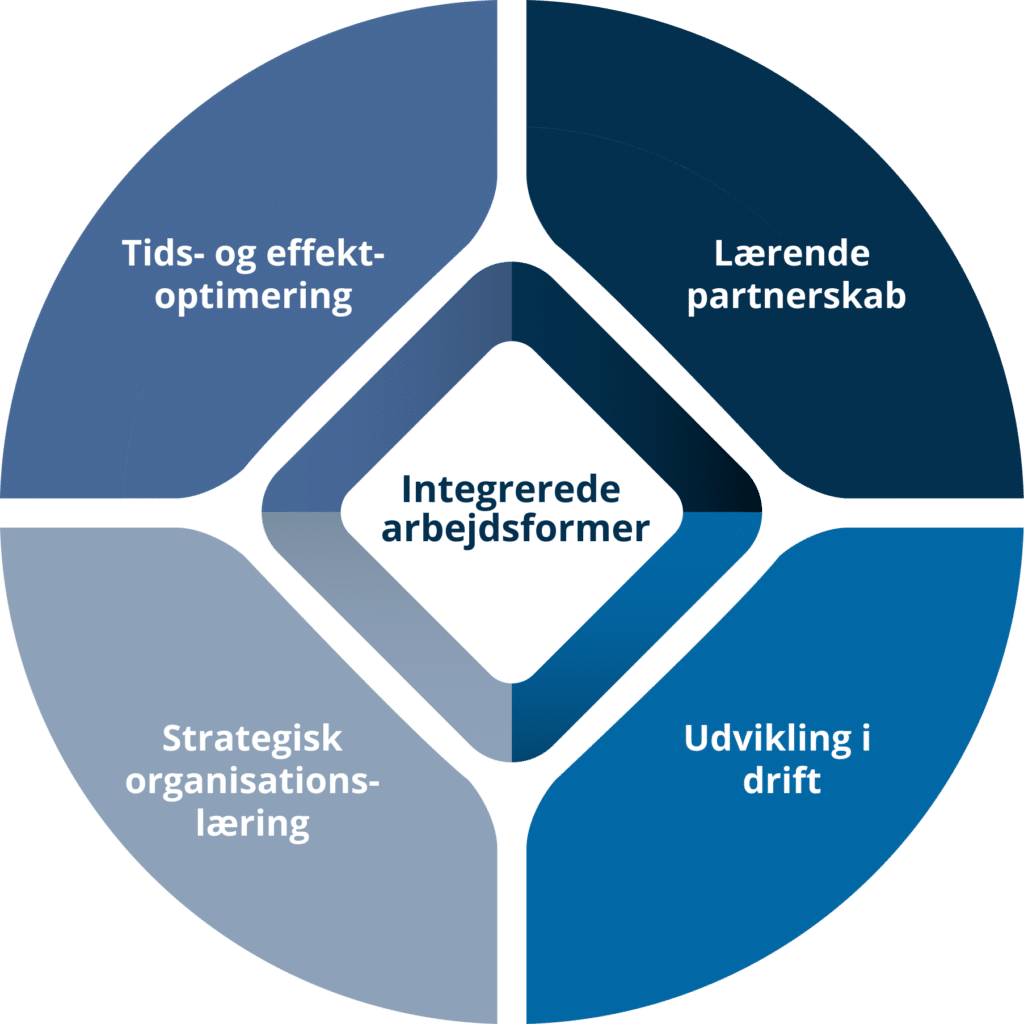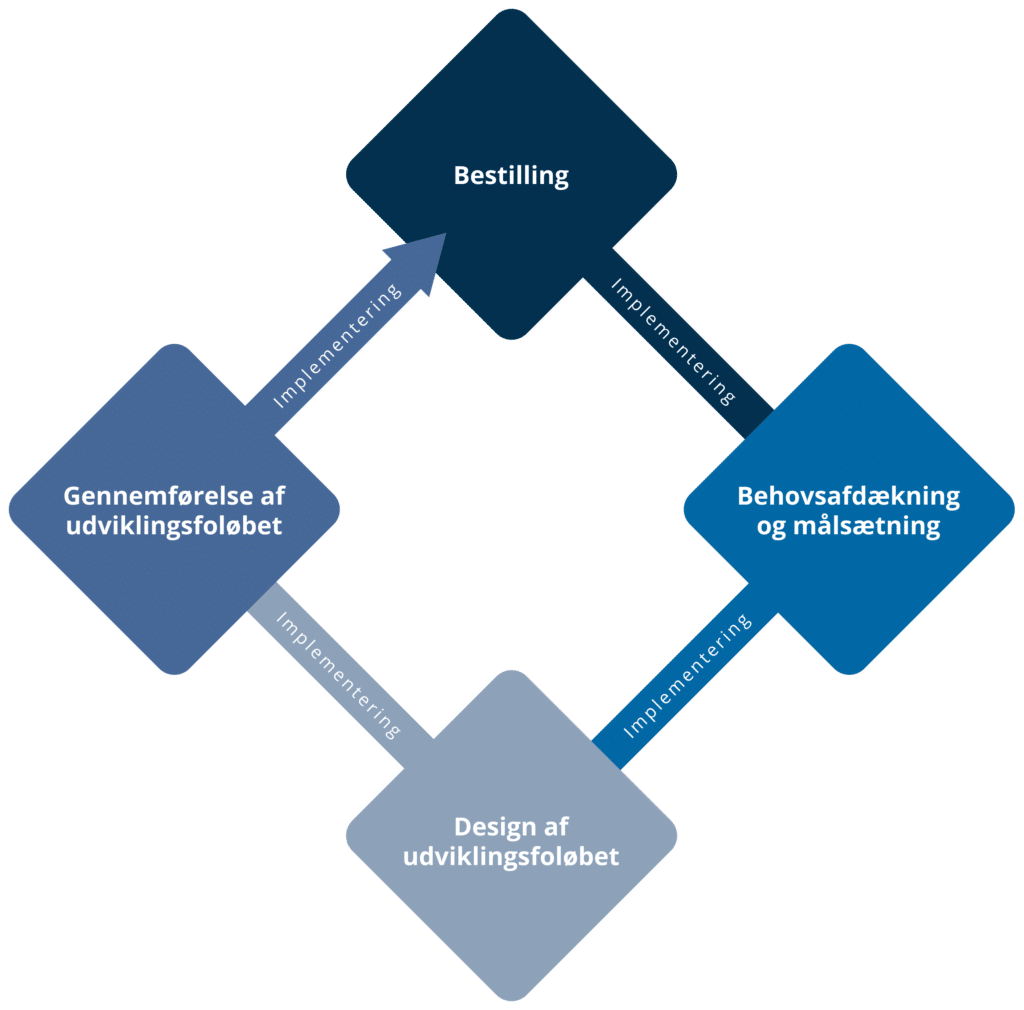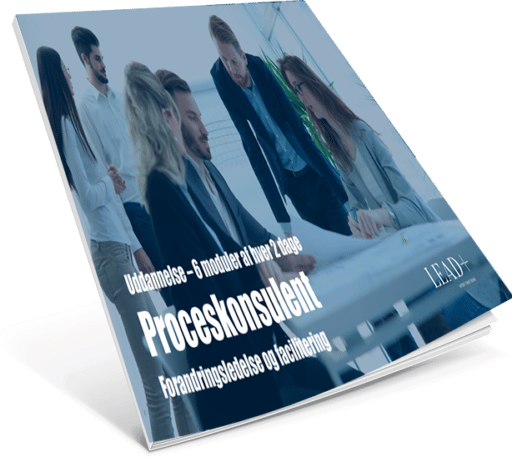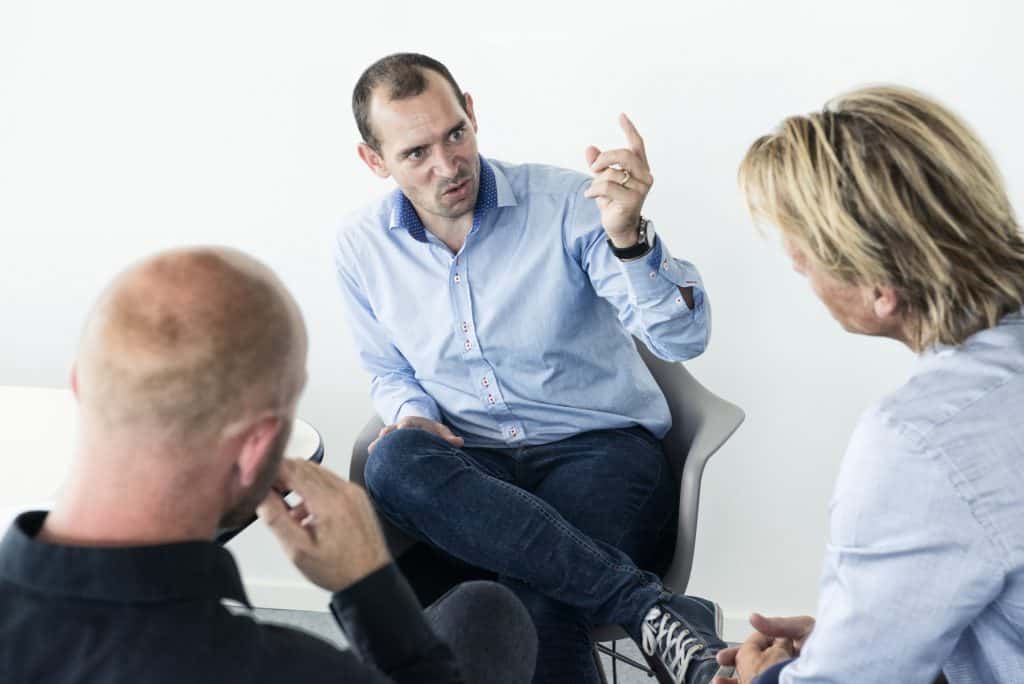Frame your change process with a new practice and research-based model
The five-factor model sets the framework for a new practice- and research-based direction for consulting work within organizational development and change. The model integrates soft and hard development methods with a focus on creating concrete results, achieving strategic goals and strengthening the organization's structure, competencies and culture.
Behind the five-factor model for development consultants
The model was created in the knowledge project "The role and working methods of the development consultant in today's successful change". Here, a group of 100 practice experts consisting of strategy managers, HR development managers, development consultants and others worked to summarize their experiences with development projects against the latest research in implementation, change management and organizational learning. Through this work, we identified five working principles that together make up the Five Factor Model.
In this article, we first review four common requirements and conditions for development projects today. We then go through the five factors in the five-factor model, clarifying and exemplifying their practical significance directly, practically and without numerous references to theory and research.
Conditions and requirements for development projects in today's organizations
In recent years, there has been a major shift in the requirements for and the scope of development projects that aim to change organizational behavior and performance. These are as follows:
Requirements and conditions 1: Increasing time and resource pressures
The practice experts in the knowledge project, "The role and working methods of the development consultant in today's successful change", painted a picture of significantly increased pressure on time and resources. The pressure really took hold during the financial crisis, when many experienced a fierce cost-cutting and optimization agenda. The use of development consultants was severely curtailed, while at the same time, demands were made for the probability of Return On Investment in development projects.
The use of performance management, KPI regimes and evidence-based methodologies increasingly gained traction in public and private organizations as Lean and other optimization techniques gained traction. Overall, this changed the culture of the use of consultants in many ways, who must now be able to explain, visualize and define the service being delivered in a way that fits into the new reality. The development consultant, like everyone else, must deliver more and faster for less.
Requirements and conditions 2: Digitalization and social media
The society around us is digitalizing at lightning speed. This creates a natural demand for the use of digitalization, e-learning, virtual learning spaces and social media in development projects. This development can be challenging because traditional consultative methods are typically created in a different technological age. At the same time, digital natives are already entering the workforce. Development consultants are therefore often put to the test when required to apply common methods and traditional tools in a digitalized world.
As a result, the requirements for mastering the use of social media and integrating it into the task solution are increasing. At the same time, it brings about a number of changes in the way development consultants work, where the physical space dissolves and merges with the digital, and lightning-fast responses are expected at all hours of the day and night.
Requirement and condition 3: Increased speed on all levels
The practice experts also pointed out that increased speed at all levels emerged as an overarching societal condition that provides a context for the work of development consultants. The experience is that everything is getting faster and faster while at the same time increasing complexity. Roughly speaking, this means that it is the fast development projects and processes that win out over the long, slow and perhaps more reflective processes. Long-term planning used to have a horizon of perhaps 10 years. Now, long-term is just looking two years ahead. Similarly, this means that traditional long-term planning strategies are increasingly being replaced by short, iterative processes, which has a major impact on the development consultant's methods and project understanding.
Requirements and conditions 4: Change and process fatigue
Since the financial crisis, many organizations have been in a rising tide of change. Over the past 10 years, most managers and employees have experienced a myriad of restructurings, mergers and leadership changes. Each of these changes has inevitably led to visioning processes, new strategies, retreats and various attempts at meaning-making.
This has two implications for development consultants: Firstly, the mantra that change itself is the only stable thing is seemingly becoming true. This challenges traditional thinking about change and development processes, which is based on the idea that change is something temporary that the consultant helps the organization manage. After that, it's back to the stable everyday life. Secondly, the average manager or professional has been changed and processed so much that many have become process fatigued.
It is therefore a dilemma for the development consultant that virtually all theory about change and consultative work rests on the basic premise that change succeeds through involvement and ownership, and that the change project must end up in a stable operation. There is therefore a need for new thinking and methods to frame development work in this new context of ongoing change.
In the following, we look at how these demands and trends are challenging established consultative schools.
The article continues in the next section.
Which process consultant training should you choose?
Listen to LEAN Consultant Jane Bøving Larsen and IT Tester, Implementation Consultant and Coordinator Christine Kjeldgård talk about why they have chosen to take their process consultant training with a special focus on change management and facilitation at LEAD - Enter next level.
Would you like to be trained by the country's leading process consultants? LEAD is behind some of the country's largest programs such as top management programs for the Danish Association of Local Authorities, the Danish State and the Regions, but we also train change agents at a wide range of private organizations such as Coop, Ørsted, Novo Nordisk and many others.
In addition to years of experience, our trainers have their finger on the pulse of our customers every day. That's why we know the challenges of putting theory into practice. We always make sure to combine the latest research with practical experience from organizations across the country.
The need for renewal of the consulting practice field - the relevance of the five-factor model
The above developments have led to a significant shift in the requirements for development consultants' work and methods, which challenges the consulting practice field enormously. The field is dominated by two competing main directions, each of which struggle to produce the desired results and do not match the requirements set out above.
One main direction is the expert approach, where the consultant drives development and change processes based on a perception of knowledge as objective truth, generated on the basis of in-depth and long-term analysis and expert advice. Here we find the prototypical strategy and operations consultants who, with quantitatively based organizational and market analyses, cost-benefit calculations and standardized concepts, produce detailed reports and recommendations with rational, long-term master plans and top-down oriented, instruction-based implementation programmes aimed at changing the organization's structure, governance and processes. This analytical work is often done by teams that, once the older and experienced partner consultant has left the meeting room, consist primarily of young talent. The problem with this approach is typically a lack of ownership in the organization and a lack of competence to implement the change, as well as a rapid obsolescence of plans (Molly-Søholm et al. 2010, Hamel & Zanini, 2014).
The second main direction is the process consultation approach, which involves letting organizational members develop their own solutions, possibly inspired by training-based input. Here, the relationships, process qualities, relevance of the training, ownership, competencies and individual meaning-making become crucial. This is where the few experienced process consultants drive the work. The problem with this approach is typically a lack of concrete operational results and a lack of organizational anchoring in structures, governance, technology and rewards (Molly-Søholm et al. 2010).
Neither of the two directions is overall successful in supporting change that achieves organizational goals. Various summarizing empirical research systematically shows this (Kotter, 1996; Beer & Nohria, 2000; Elmholdt, Keller & Tanggaard, 2015; Conrad, 2015). Furthermore, this picture is confirmed by numerous studies of top managers' experiences with strategy implementation executed by the organization itself or supported by external consultants (Dye & Sibony, 2007).
In other words, there is a need for a renewal of consultative approaches, and this is where the five-factor model comes into play. In the following, we elaborate on each of the factors in the five-factor model.
Use the five-factor model in your work as a development consultant
As described in the introduction, we have used the experiences of 100 practice experts to identify the working principles and building blocks that characterize successful change today. We compared this to the latest research on successful implementation, change management, process consultation and organizational learning.
Based on this, we can give an overall description of the development consultant of the future, as below:
Today, the internal and external development consultant is expected to be able to design and facilitate development processes with the following common characteristics:
- The development program is framed and sponsored by top management.
- The development process is linked to strategic initiatives and goals.
- Each project is developed, targeted and implemented in close collaboration with the organization's managers, key personnel, internal and external development consultants to build competencies and capacity.
- The behavioral changes are supported by changes in organizational structure and governance.
- The development activities have a dual focus on strengthened business performance and strengthened behavior and competencies.
- The development activities are aimed at and interwoven with the actors' everyday tasks.
- The development project uses IT-supported methods, social media and virtual workspaces to minimize time and optimize communication where appropriate.
The five-factor model examines the way of working described by the seven characteristics.
the 5 factors of organizational change in the five-factor model
In the following, we take a closer look at the five factors and how they can be translated into development project design, strategic approaches and consultative methods.
The first factor is comprehensive and fundamental to understanding the organization, change and the role of the development consultant. The remaining four factors are more limited and practically oriented.
The article continues in the next section.

Want to be even better equipped to manage processes?
LEAD's research-based process consultant training gives you the methods to design, facilitate and lead strategic development processes and changes to create the impact you need.
This is an education for those who work with development, processes and change management.
Read more about the process consultant training here
Factor 1: Integrated ways of working
Integrated ways of working suggest a shift away from a mindset based on either an expert consultant approach (management-based, analytical, 'hard' management and structural solutions) or a process consultant approach (process-oriented, 'soft' meaning, culture and competence development approaches). Instead, it points to an integrative thinking about the organization, change and the role of the development consultant, consisting of a range of working methods that combine the strategic, structural, knowledge and management-based methods with facilitative and learning methods for ownership and competence development. The traditional expert consultant's focus on the "hard" side of the organization (impact, performance management, structure, etc.) is thus integrated with the process consultant's focus on the soft side of the organization (relationships, meaning, motivation and competencies, etc.).
It addresses the contradictions between being an expert consultant and a process consultant, as well as the contradiction between top-down approaches to development (focus on governance and top-down decision-making and implementation) and bottom-up approaches (focus on involvement and co-creation of solutions).
This poses a double challenge to the consultant:
Firstly, you must be able to understand and work partly based on the process consultant's methods for involving, creating meaning and common goals, strengthening relationships and developing competencies, and partly based on the expert consultant's methods for applying analytical models and evidence-based knowledge and developing by changing the organization's structure and governance.
Secondly, you need to be able to design change that integrates ongoing top-down framing (i.e. top management's goals, framing and ongoing involvement) with bottom-up involvement of stakeholders at all levels that provides real agency.
Of course, it can be an extensive task for the development consultant to span such a wide range of knowledge, competencies and skills. Therefore, working with integrated working methods in practice will often be done by the development consultant, in dialogue with the organization, putting together a team that can work together to bridge the gap between the two approaches and thus create a holistic development process. Here, the key competence for the development consultant is to orchestrate the team's work and ensure that the necessary knowledge and skills are brought into play at the right time, so that the two approaches "talk to each other" in a way that ensures coherence between, on the one hand, analysis, structures and management and, on the other hand, involving and meaning-making processes with a focus on skills, mindset and culture.
This has a number of fundamental consequences for how the development consultant approaches the task in a development project. Looking at the below visualization of prototypical phases in a planned development project, three of the model's progress points in particular are central to the factor.
The prototypical phases of a planned development project.
In the initial phase of a development project (phase 1: Commissioning), it is crucial to clarify whether the organization is willing to work with development with an integrative focus on the "hard" side of the organization and the "soft" side of the organization. It is by no means a given that the organization wants this. Perhaps the level of ambition is only for an inspirational presentation from the consultant, or perhaps the decision-makers, for strategic reasons, do not want to commit as much as the five-factor approach requires.

Factor 2: Learning partnership
Learning partnership is a fundamental way of working between the organization's key players and external as well as internal development consultants. The basic idea is that development should take place in a close, mobilizing, competence- and capacity-building collaboration between the relevant stakeholders.
The experience of our practice expert group clearly shows that the time is past for disconnected projects that are primarily driven by external development consultants. The common experience here is that the impact of the projects usually disappears with the departure of the consultants. In addition, the external consultant rarely has access to everything that goes on "behind the scenes" in the organization, or knowledge of other initiatives and processes in the organization that are relevant to the specific development project. At the same time, the solution is not to go in the opposite direction and rely purely on internal development consultants. Internal consultants usually have the deep organizational knowledge and relationships to connect the project with the right players and initiatives. However, they often lack the deep specialist expertise within the theme of the development project, as they typically need to be broad in their task portfolio.
The following principles are central to learning partnerships:
- Turn the heaviest and most important players in the organization into skilled ambassadors of change! Basically, the project needs to connect with the "impacted and influencing" stakeholders, representing those who are impacted by the project and those who can influence the project. Ideally, the following are represented: The affected areas' formal managers, leaders, key employees and internal and/or external development consultants.
- Knowledge, ownership and competence must be built up along the way among the organization's key people. They must therefore be the primary players in driving the change from day 1, so that the change has ambassadors and role models and thus persists the day the development consultant leaves the project.
- Give away your methods! Create a learning experience for the customer by giving away your methods and tools. By acting as a master teacher, the players become skilled and competent. Only then can the project live on after you leave.
- Enable learning in yourself! When working with complex issues, consultants need to be able to learn along the way and change and develop their own methods. It's not always possible to predict what will happen or what a given challenge will entail. Therefore, make sure to get explicit feedback on an ongoing basis and avoid locking yourself into your own methods.
- Build the customer's capacity to co-create learning with others. The customer's ability to innovate and evolve depends largely on their ability to get others to support their innovation or do things in new ways themselves.
The second factor of the five-factor model, Learning Partnership, is of great practical importance in development projects in terms of who the development consultant involves and how.
In phase 4 (Implementation of the development project), the Learning Partnership factor becomes most evident. Here, the consultant takes on the role of master teacher and builds up the internal key players with the partner working method to be able to drive the agreed learning processes and improvements themselves.
The consultant facilitates and project manages with a consistent focus on supporting organization members in building new habits and embedding them in new processes, tools and in the ongoing management and rewarding of members.
Factor 3: Development in operations
The Development in Operations factor involves breaking the traditional distinction between development and operations as two different areas of focus. The trend across various forms of organizational and leadership development is a growing insistence that development should be an integral part of operations and task performance.
Development in operations should be seen in the context of the massive investments in recent years in master's and diploma programs for managers and other forms of competence-granting education. The many who have participated are generally very happy with the programs and perceive them as relevant, but the transfer challenge is great, and the desired effects of what has been learned are rarely achieved. Typically, only about 10% of participants in education programs succeed in transferring what they have learned in a value-creating way (Beer et al., 2016). Participants in our knowledge project pointed to a growing awareness of this problem and that the next big waves of development will be much more closely connected to everyday life.
The key for development consultants here - with Development in Operation - is to turn the application arena into the learning arena. Here, the consultant must partially rethink how to work in a consultative manner. This involves moving away from the automatic thinking that development processes should be designed so that individuals go to course centers and are generally formed and developed there. Instead, a large part of the development activities should take place as an integrated part of daily life, while the participants go about their work as much as possible. This means that the consultant largely becomes a participant in and developer of daily practice.
Important consultative methods and approaches here are to use customers' challenging tasks as the contexts in which the consultant can frame and facilitate learning. Concrete approaches such as learning meetings, shadow coaching, live feedback, peer learning, mastery learning, mentoring, interdisciplinary project groups, observation and feedback on whiteboard meetings and other forms of micro-interventions often win out over retreats or classrooms. In this way, the core practical methods are geared towards learning in practice.
Factor 4: Strategic organizational learning
The factor Strategic Organizational Learning implies that the development project is designed into a committed, strategically targeted and top management-supported organizational framework. Furthermore, it implies that the development project works with "the influenced and influencers" from an organizational perspective.
The fourth factor of the five-factor model thus denotes a move away from traditional development work, where learning is predominantly focused on individuals, individual groups or individual departments, detached from the strategic goals, top management's framework and follow-up, and the organization's goal management and structure.
Instead, Strategic Organizational Learning suggests a practice where development projects are designed to create learning that is framed and sponsored by top management and thus linked to the organization's strategic initiatives and goals. Furthermore, development projects involve the networks of actors, groups and departments that together produce what needs to be improved. The desired behavioral change is supported by changes in the organizational structure and governance.
The idea is that successful change is created through a more holistic, holistic approach.
This factor marks a break with the previously widespread ideals that development activities should be carried out with a general goal of inspiring and promoting general education and critical thinking for the individual - an ideal that is rooted in Grundtvig's thoughts on education and lifelong learning, which has had enormous significance in Denmark, and which is still the starting point for a large part of the competence development that takes place in both public and private organizations. The problem with this approach to competence development in organizations is that the organization's governance, priorities and goals, culture, tools, etc. often prevent organization members from doing what they have learned. This creates a gap between the methods/skills/tools being trained and the context in which they are to be applied. In change theory, this problem is referred to as the knowing-doing problem (Pfeffer & Sutton, 2000).
In a recent article by one of the grand old men of Change Management research, Michael Beer - aptly titled "The Great Training Robbery" - the authors make exactly the same point, that organizational context is crucial to the success of behavioral and competency development activities:
"...the organizational and management system, the pattern of roles, responsibilities and relationships shaped by the organization's design and leadership that motivates and sustains attitude and behavior is far more powerful in shaping individual behavior than the capacity of well trained, even inspired, individuals to change the system (...) We advocate a new logic. Senior executives and their HR professionals should embed individual or group development in an organization change and development strategy motivated and visibly led by the senior team. This contrasts sharply with the pervasive HR logic that leaps from strategy to definition of requisite individual competence and training, and neglects the systems perspective" (Beer et.al., 2016)
This is exactly what our development work with the 100 practice experts points to with Strategic Organizational Learning: "a new logic" that involves a fundamental shift from a focus on individual or group learning to community learning in a committed organizational context. In concrete and practical terms, this means that the development project is designed so that it:
- Is framed and sponsored by senior management
- Is linked to strategic initiatives and goals
- Is supported by changes in organizational structure and governance
- Involves the networks of actors, groups and departments that together produce what needs to be improved.
Podcast
At LEAD, we are constantly working to create new and improved knowledge. We want to share that knowledge with you.
Learn more about LEAD's process consultant training, the key points to be aware of as a process consultant with a focus on the clarification phase. How do you get off to a good start?
Factor 5: Time and power optimization
The final factor in the five-factor model relates to the significantly increasing pressure to deliver more and faster with less time.
This requirement is a basic condition for development consultants and organizations alike. Philosopher Paul Virilio describes the continuous increase in speed driven by technological development as the most significant factor in the evolution of our society and relationships:
"Today we are entering a space which is speed-space ... This new other time is that of electronic transmis- sion, of high-tech machines, and therefore, man is present in this sort of time, not via his physical pres- ence, but via programming (...) The speed at which something happens may change its essential nature, and that which moves with speed quickly comes to dominate that which is slower."- Paul Virilio
In the last decade, speed has accelerated like never before, driven by the age of digitalization and automation. Many of the fundamental traditional development consulting practices developed from the 50s through to the 80s2 are based on conditions, technology and an understanding of speed that belongs to a different age.
Examples of this could be frequent, short Skype-based learning pitstops in small groups, where participants take turns evaluating their progress against the agreed learning objectives, as shown on the right.
Experienced consultants will see a single modern technology-enabled version of Kolb's learning cycle (Kolb, 1982), which is widely used in agile project management.

The practitioners in our project point to two things that were particularly important: Constructive coasting and constructive counter-coasting. This means that in some situations you need to be able to speed up and accelerate the pace of development processes, while in others you need to be able to put on the brakes and slow things down. If we take a closer look at the concept of constructive coasting, it refers to the ability to create development in new and faster ways - often by using new forms of technology. Examples include methods such as nudging and persuasive design. Nudging, in short, is the act of nudging people in their familiar surroundings to change their behavior, while persuasive design is the ability to influence people's behavior on an ongoing basis. Examples of persuasive design can be health watches that through vibrations inform and reward you for your physical behavior, while nudging can be markings on the asphalt that guide you to the nearest trash can with the aim of influencing you to throw your trash in there instead of throwing it in nature.
At the same time, development consultants must be able to use social media as a tool to involve different actors on new platforms in change processes. As an example, the practice experts pointed to the ability to involve customers, citizens, companies and other stakeholders in change processes using Facebook, Twitter and other social networks. There is thus a movement underway to move away from a focus on the presence of participants in physical spaces, which are often characterized by slower processes.
But paradoxically, the practice experts point out that in many situations there will also be a need for constructive counterflow. This means that as a development consultant, you need to be able to slow down drastically. This can be done by challenging the very premises of the task that the client wants you to solve. It can also be by consciously working to create reflective and dialogical spaces that are decoupled from instrumental performance management. Such reflective spaces will often require stepping out of the connected world - and getting people to do something as relatively simple as handing in their phones is a powerful intervention in itself.
In short, the principle of time and impact optimization is about development consultants' ability to balance between when to jump on the bandwagon and accelerate at the pace required by the change or environment, and when to slow down, be reflective and realistic, and have the courage to stand firm when necessary.
In line with the above, it also requires the consultant to create impact documentation through qualitative and quantitative data from start to finish of the intervention. We're not talking about large, classic final evaluations that take up several binders, but rather the creation of broad-spectrum microdata. This can be done through a myriad of different methods:
- Participants who continuously track their progress on an app through self-assessment
- Mini surveys
- Selected stories ("success cases" or "learning cases") are shared on a Facebook page for the project
- Work closely to monitor effects on selected key figures
The goal is twofold: On the one hand, measurement is an intervention in itself that, when done well, can enhance learning and development. On the other hand, measurement is a legitimization and promotion of the project and its actors. Factors that are crucial to ensure the necessary support.
Five Factor Consulting: Working principles for the planned development process
The final factor in the five-factor model relates to the significantly increasing pressure to deliver more and faster with less time.
This requirement is a basic condition for development consultants and organizations alike. Philosopher Paul Virilio describes the continuous increase in speed driven by technological development as the most significant factor in the evolution of our society and relationships:
FemfaktorConsulting offers a number of fundamental but also operational working principles for the typically planned development process. The phasing of the prototypical project indicates the sequential breakdown of the overall activities:
But it does not say anything about the consultative craftsmanship, the nature of the consultant's methodical toolbox for needs assessment and goal setting, design and implementation of the development process, the division of roles between internal/external development consultants, managers and key employees, etc. This is where "The role and working methods of the development consultant in today's successful change" and the five-factor model provide a number of principled instructions on how to implement the consultative working methods so that we have a greater chance of getting development with results.


Do you want to get better at:
- Clarify the organization's real issues
- Create a design that matches the unique problem
- Read a room and facilitate effectively
- Communicate the right messages that create engagement and followership
- Be more confident in your role as a process manager
- Integrate top-down and bottom-up processes
- Design and implement engaging and varied ways of working
- Increase speed by using behavioral design
- Develop and implement in an agile way - adapting as the situation changes.
Fill out the form below and receive our description of the research-based process consultant training that gives you the most powerful tools for process management in practice.
Bibliography
Beer, M. & Nohria, N. (2000). Cracking the code of change. Harvard Business Review, May-June, 133-141. Beer, M., Finnstrom, M. & Schrader, D. (2016). The Great Training Robbery. Harvard Business School.
Conrad, T. (2015). "Leadership and change in primary and lower secondary schools", In: "Implementering - Fra viden til praksis på barn- og ungeområdet". Danish Psychological Publishing House.
Dye, R. & Sibony, O. (2007). How to improve strategic planning. The McKinsey Quarterly, Booklet 3.
Elmholdt, C., Keller, H.D., & Tanggaard, L. (2015). Management psychology. Frederiksberg: Samfundslitteratur.
Hamel, G. & Zanini, M. (2014). Build a change platform, not a change program. xxxx
Kolb, D. (1982). Experimental Learning. Experience as the Source of Learning and Development. USA, New Jersey, Englewood Cliffs.
Kotter, J.P. (1996). Leading Change. Harvard Business School Press.
Lewin, K. (1947). Frontiers in Group Dynamics: I. Concept, method and reality in social science; social equilibria. Hum. Relat. 1:5-40.
Molly-Søholm, T., Willert, S., Rosenmeier, J. & Andersen, H.S. (2010). Action Learning Consulting - Strategic process consulting in theory and practice. Danish Psychological Publishing.
Pfeffer, J. & Sutton, R.I. (2000). The Knowing-Doing Gap: How Smart Companies Turn Knowledge into Action. Harvard Business School Press
Schein, E.H. (1999). Process consultation revisited: Building the helping relationship. Reading, MA: Addison-Wesley Publishing Company, Inc.




